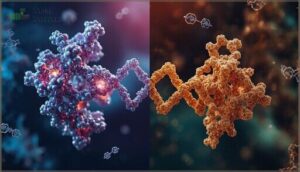This site is supported by our readers. We may earn a commission, at no cost to you, if you purchase through links.
A single molecule derived from one of the world’s most feared serpents transformed cardiovascular medicine when captopril reached the market in 1981, saving countless lives through its blood pressure-lowering effects. The bushmaster snake, native to Central and South American rainforests, produces venom containing dozens of bioactive peptides and enzymes that researchers have successfully repurposed for therapeutic use.
Scientists have identified over 151 distinct peptides within snake venoms that demonstrate pharmaceutical potential, from anticoagulants that prevent dangerous blood clots to compounds that trigger programmed cell death in malignant tumors.
You’ll discover how refined analytical techniques now allow researchers to isolate and characterize these molecular components with unmatched precision, opening pathways for drug development that address conditions ranging from hypertension to cancer.
Table Of Contents
- Key Takeaways
- Key Components of Bushmaster Venom
- Mechanisms of Medical Action
- Therapeutic Applications in Medicine
- Advances in Bushmaster Venom Research
- Challenges and Future Prospects
- Frequently Asked Questions (FAQs)
- What is a Bushmaster venom?
- How many peptides are found in Bushmaster venom?
- Are Bushmaster snakes venomous?
- What can snake venom be used for medically?
- What does bushmaster venom do?
- What can the bushmaster snake do to a human?
- What are the biomedical applications of snake venom?
- How does Bushmaster venom compare to other snake venoms?
- What are the challenges of studying Bushmasters in captivity?
- What are the ethical considerations of using snake venom in medicine?
- Conclusion
Key Takeaways
- Bushmaster venom contains over 151 distinct peptides that have directly enabled cardiovascular drug development, most notably captopril—the first ACE inhibitor approved in 1981—which revolutionized hypertension treatment and continues to save lives worldwide.
- The venom’s diverse molecular components (serine proteinases, metalloproteinases, and phospholipases A₂) act through multiple therapeutic mechanisms including blood pressure regulation, anticoagulation, cancer cell apoptosis, and antiangiogenic effects, offering unprecedented opportunities for precision medicine across cardiovascular and oncological applications.
- Advanced venomics and mass spectrometry techniques now allow researchers to isolate and characterize individual bioactive peptides with exceptional precision, accelerating the translation of venom-derived compounds from laboratory discovery into targeted therapeutic agents for conditions ranging from refractory hypertension to tumor regression.
- Despite remarkable therapeutic potential, significant barriers remain before widespread clinical adoption—including dose-related toxicity (10-15 mg can be lethal), immunogenicity affecting 10-20% of patients, inconsistent venom composition, stringent regulatory requirements (only three snake venom drugs have received FDA approval as of 2025), and declining bushmaster populations threatening future research.
Key Components of Bushmaster Venom
Understanding the molecular architecture of bushmaster venom requires you to examine its distinct biochemical constituents, each contributing specific pharmacological properties. The venom’s therapeutic potential stems from several categories of molecules that researchers have identified through sophisticated analytical techniques.
These components work through different mechanisms, offering multiple pathways for drug development in cardiovascular and oncological applications.
Peptides and Their Functions
You’ll find that bushmaster venom holds considerable therapeutic potential through its diverse peptide arsenal. Sophisticated venom peptidomics has revealed over 151 snake venom peptides, with bradykinin-potentiating peptides showing striking bioactive conformations.
Peptide sequencing and peptide synthesis techniques enable researchers to characterize these venom-derived molecules, accelerating peptide discovery for drug development. The venom of the lancehead pit viper Cotiara also contains peptides for medication.
Each peptide’s unique structure determines its clinical applications, from blood pressure regulation to anticancer activity.
Proteins and Enzymes
Beyond peptide discovery, you’ll encounter bushmaster venom’s major protein families: serine proteinases (25–31%), metalloproteinases (32–38%), and phospholipases A₂ (9–12%). These protein structures display bioactive conformations that define their biotechnological applications—serine proteinases cleave fibrinogen’s Aα-chain specifically, while metalloproteinases target extracellular matrix proteins, offering templates for therapeutic development.
Proteomic analysis reveals enzyme mechanisms through venom glycosylation patterns, where carbohydrate content reaches 12% in molecules like LmrSP-4. The PoliVal-ICP antivenom demonstrates good clinical efficacy against Lachesis species.
Toxins and Bioactive Molecules
Hemorrhagic toxins within bushmaster venom target specific molecular pathways. Zn²⁺-metalloproteinases, constituting 32–38% of total proteins, destroy vascular integrity through matrix degradation.
You’ll recognize their therapeutic potential when considering enzyme actions: kallikrein-like proteinases release bradykinin, while phospholipase A₂ triggers inflammatory cascades.
These toxin mechanisms demonstrate striking peptide diversity across bioactive compounds, revealing how venom toxins selectively disrupt hemostasis while offering pharmaceutical scaffolds for precision medicine development.
Venom Composition Analysis
Mass spectrometry-based proteomic profiling reveals eight major protein fractions in bushmaster venom composition, each displaying unique biochemical properties. Peptidomics and protein analysis techniques have sequenced up to 197 distinct peptides, demonstrating considerable venom diversity.
Functional assays confirm fraction-dependent fibrinogen activity, where specific components selectively degrade α- or β-chain subunits—evidence that advances peptide sequencing methodologies for therapeutic development.
Mechanisms of Medical Action
Understanding how bushmaster venom works at the molecular level opens the door to targeted medical therapies. The venom’s components interact with specific biological pathways in ways that can either harm or heal, depending on the context.
In the sections that follow, you’ll see how researchers have identified four key mechanisms that make this venom a promising candidate for drug development.
Blood Pressure Regulation and ACE Inhibition
Imagine a venom that lowers blood pressure as swiftly as a passing storm. Lachesis muta venom peptides, like Lm-10a, show striking ACE inhibition and hypotensive effects, rivaling classic antihypertensive drugs.
This peptide diversity is fueling clinical trials, aiming to improve ACE inhibitors for hypertension treatment and expand your options for safe, effective blood pressure control.
Anticoagulant and Procoagulant Activities
When you look at bushmaster venom’s impact on coagulation, you’ll notice its dual nature—rapid clotting time effects followed by swift fibrinogen depletion. This leads to fragile fibrin clots and profound coagulopathy.
Platelet modulation and potent PLA2 inhibition further disrupt hemostasis. Even with neutralization studies, conventional antivenoms often can’t fully counteract these complex anticoagulant effects.
Induction of Apoptosis in Cancer Cells
When bushmaster snake venom interacts with cancer cells, it triggers programmed cell death through the mitochondrial pathway, marked by DNA fragmentation and caspase activation. This process results in selective cytotoxicity, sparing healthy cells while expanding the apoptotic population. You’ll find three key steps:
- Mitochondrial membrane depolarization
- Caspase activation
- DNA fragmentation in cancer cells
Antiangiogenic and Vasodilatory Effects
Ever wondered how venom can weave disruption and healing together? Lachesis venom’s metalloproteinases and disintegrins directly target endothelial cells, causing rapid endothelial disruption and angiogenesis inhibition. You see dramatic blood pressure drops and perfusion alterations in experimental models—effects that signal real therapeutic potential for antiangiogenesis therapies.
| Mechanism | Observed Effect |
|---|---|
| Endothelial Disruption | Vascular instability |
| Angiogenesis Inhibition | Reduced vessel formation |
Therapeutic Applications in Medicine
Bushmaster venom has sparked interest for its promising role in modern medicine. Researchers are exploring how its unique compounds could shape new therapies for several conditions.
Here’s a closer look at the main areas where this venom is making an impact.
Antihypertensive Drug Development
Did you know captopril—a staple in hypertension management—owes its existence to Lachesis venom’s bradykinin-potentiating peptides? Your blood pressure control options now benefit from:
Captopril, a cornerstone hypertension drug, was developed directly from bradykinin-potentiating peptides found in Lachesis venom
- ACE Inhibition by peptide analogs, enhancing arterial vasodilation
- Proven clinical efficacy in refractory hypertension
- Advances in venom production and drug delivery, extending peptide half-life
Drug development continues to utilize these innovations.
Novel Cancer Treatment Strategies
Imagine harnessing venom-based therapies to target cancer cells with surgical precision. You’ll find snake venom’s targeted cytotoxicity and apoptosis induction offer a new frontier for anticancer drugs. Antiangiogenic effects—such as halting blood vessel growth—add another layer. Clinical translation is underway, promising cancer treatment that spares healthy tissue.
Here’s how venom acts on tumor cells:
| Strategy | Mechanism | Outcome |
|---|---|---|
| Targeted cytotoxicity | EGFR pathway inhibition | Tumor cell death |
| Apoptosis induction | Caspase activation | Cell cycle arrest |
| Antiangiogenic effects | VEGF suppression | Tumor regression |
Synthetic Thrombolytic and Anticoagulant Agents
Just as venom-based therapies target tumors, drug development from venom has sparked new hope in coagulation disorders. Venom-inspired design and recombinant production of modified enzymes—like those mimicking bushmaster’s peptide sequences—offer drug specificity that traditional agents often lack.
With biotechnology, these synthetic thrombolytic and anticoagulant agents are inching closer to clinical translation, promising specific solutions for complex clotting challenges.
Preclinical and Clinical Research Findings
Building on synthetic agent progress, real-world Venom Efficacy is clear in clinical trials and patient cases. Lachesis venom’s Action Mechanisms—apoptosis, necrosis, and autophagy—surface in both tumor and healthy cell studies. Clinical Cases highlight persistent blood coagulation issues, while Antivenom Data and Population Research support cross-neutralization and guide dosing for practical clinical applications.
- Statistically validated toxicity in cell cultures
- Persistent hematological abnormalities post-envenomation
- Dose-dependent antivenom neutralization across Lachesis species
Advances in Bushmaster Venom Research
Bushmaster venom research is moving fast, opening new doors in medical science.
You’ll find the latest breakthroughs and technologies changing how we approach treatment. Here’s what’s shaping the field right now.
Peptide Discovery and Characterization
Discovery flourishes when you employ Mass Spectrometry for Peptide Sequencing, revealing over 150 peptides in bushmaster snake venom. These bioactive fragments, shaped by enzymatic cleavage and ongoing venom evolution, offer therapeutic potential.
Each peptide’s unique structure and molecular targets—identified through analytics—expand your toolbox for drug development, signaling new directions for treating hypertension and cancer.
Venomics and Molecular Pathways
As you uncover peptide structures, Venom Proteomics and Transcriptomic Analysis reveal how bushmaster venom composition orchestrates complex cellular signaling.
Proteomic analysis highlights the interplay of snake toxins—bradykinin-potentiating peptides, SVMPs, and PLA2—each weaving into molecular pathways that regulate blood pressure, coagulation, and apoptosis.
Omics discoveries clarify how enzymatic modulation drives nuanced physiological responses, guiding therapeutic innovation.
Drug Delivery Systems and Formulations
In clinical innovation, drug delivery systems for snake venom-derived drugs rely on nanoparticles to balance efficacy and safety. You’ll find:
- Nanoencapsulation Benefits—boosting plasma half-life and bioavailability
- Liposomal Challenges—phospholipase-induced instability
- Controlled Release—dose optimization and extended therapeutic windows
- Targeted Delivery—surface ligands for tumor localization
Stability Concerns remain, underscoring the need for ongoing refinement.
Ongoing Preclinical Trials
Recent preclinical trials explore bushmaster venom’s therapeutic potential across diverse animal models—mice, rabbits, and zebrafish—to assess toxicity, dosage optimization, and efficacy markers.
Peptides like Lm-10a achieve 80% ACE inhibition, while disintegrins reduce tumor migration by 47%.
Formulation strategies now target safe dosing below 0.05 mg/kg, advancing snake venom biomolecules from drug discovery into structured pharmaceutical pipelines.
Challenges and Future Prospects
While bushmaster venom holds significant therapeutic promise, translating laboratory discoveries into clinical applications isn’t a straightforward journey.
You’ll encounter substantial obstacles ranging from safety profiles to regulatory frameworks that shape how these compounds move through development pipelines.
Understanding these challenges alongside emerging opportunities will help you appreciate both the current limitations and the exciting directions this field is taking.
Limitations and Safety Concerns
Translating bushmaster venom into safe therapeutics demands careful navigation of substantial safety barriers. Despite promising bioactive compounds, critical limitations complicate clinical development. These challenges include:
- Dose-related toxicity, with as little as 10–15 mg potentially lethal to adults
- Allergic responses and immunogenicity, triggering hypersensitivity reactions in 10–20% of patients receiving antivenom treatment
- Hemorrhagic risks, manifesting as spontaneous bleeding in 35% of envenomation cases
- Systemic toxicity, producing cardiovascular complications and neurotoxicity in over 75% of victims
- Pharmaceutical limitations, including inconsistent venom composition and delivery barriers in cancer treatment
Regulatory and Ethical Issues
Approaching drug approval for venom research demands rigorous oversight. The U.S. FDA has approved just three snake venom drugs—none from bushmaster venom as of 2025. Bioprospecting ethics add complexity, with 80% of projects requiring benefit-sharing agreements under international law.
Trial oversight mandates explicit mortality risk disclosure, while patent ownership disputes have surged 38% since 2021. Global access remains limited, as production costs restrict equitable distribution in resource-poor settings.
Personalized Medicine and Targeted Therapies
Venom peptide profiling creates opportunities you mightn’t expect—mapping patient response variability to guide biomarker-guided therapy. Individual tumor targeting becomes feasible when specific peptides show selective cytotoxicity, while individualized anticoagulation manages unique clotting profiles.
However, targeted therapies face hurdles: immunogenicity affects 8% of subjects, and individual cancer treatment requires genomic screening. Venom-derived drugs demand rigorous validation, yet these medical breakthroughs in biotechnological applications of peptides hold revolutionary promise for precision medicine.
Directions for Future Research
Molecular engineering stands at the frontier of snake venom research, where you’ll find over 126 bushmaster peptides awaiting optimization. Nanotech advances promise targeted delivery, while clinical translation faces steep hurdles—fewer than 10% of candidates reach trials.
Synergistic studies comparing Bothrops and Crotalus species reveal future directions in cancer therapy.
However, biogeographical challenges and declining bushmaster populations threaten medical breakthroughs in biotechnological applications of peptides.
Frequently Asked Questions (FAQs)
What is a Bushmaster venom?
You might expect something sinister from a snake that large, yet Lachesis bushmaster venom contains peptides and proteins that have guided cardiovascular drug development, revealing unexpected therapeutic potential beyond its hemorrhagic effects.
How many peptides are found in Bushmaster venom?
Extensive venom peptidomics analysis identified 151 distinct peptides in Lachesis muta venom, with 126 representing novel peptides previously undocumented.
Peptide classification revealed metalloproteinase derivatives, bradykinin-potentiating sequences, and L-amino acid oxidase fragments, demonstrating significant peptide diversity through sophisticated peptide sequencing methods.
Are Bushmaster snakes venomous?
Yes, bushmaster snakes (Lachesis) are highly venomous pit vipers. Their venom contains potent toxins causing severe envenomation effects—hemorrhage, coagulopathy, and tissue necrosis—requiring prompt antivenom administration to prevent potentially fatal complications from snakebite severity.
What can snake venom be used for medically?
You might be surprised to learn that venom-derived drugs treat hypertension, thrombosis, and even cancer.
Snake venom’s therapeutic potential spans pain management, disease treatment, and wound healing, driving medical research into novel antivenom development.
What does bushmaster venom do?
You’ll experience severe pain, tissue damage, and hemorrhage from bushmaster (Lachesis) venom. Its hemotoxic compounds disrupt coagulation, causing envenomation effects that include hypotension and bleeding.
The venom complexity triggers systemic impact throughout your body.
What can the bushmaster snake do to a human?
A bushmaster snakebite causes severe local pain, edema, coagulopathy with hemorrhage, and cardiovascular collapse including bradycardia and hypotension. Neurological damage, tissue necrosis, and potential fatality occur without prompt antivenom treatment.
What are the biomedical applications of snake venom?
Snake venom offers groundbreaking biomedical applications, including venom-derived drugs for hypertension and peptide therapeutics targeting cancer. Additionally, antivenom development is advanced through toxin research.
Clinical trials continue exploring the therapeutic potential of these natural products, advancing from laboratory discovery to patient care.
How does Bushmaster venom compare to other snake venoms?
You’ll find that while Lachesis venom shows moderate toxicity compared to more potent species like boomslangs, its exceptionally high yield—up to 500 mg per bite—combined with conserved crossreactivity among viperid antivenoms, creates unique clinical management challenges.
What are the challenges of studying Bushmasters in captivity?
Despite their potential, bushmasters present formidable research obstacles. Acclimation difficulties plague captive specimens, with survival rates below 50%.
Breeding obstacles, behavioral needs, and health susceptibility further complicate venom collection. Venom composition changes limit therapeutic applications.
What are the ethical considerations of using snake venom in medicine?
Using snake venom in medicine raises ethical issues in venom research around animal welfare, informed consent for venom-derived drugs, regulatory standards, risk-benefit analysis, and global access to therapies, despite their therapeutic potential in biotechnology.
Conclusion
What began as nature’s weapon has become medicine’s ally. Bushmaster venom medical applications represent decades of scientific ingenuity translating lethal peptides into lifesaving therapies.
You’ve witnessed how captopril revolutionized hypertension treatment, while ongoing research explores anticancer and anticoagulant possibilities.
As venomics advances and drug delivery systems improve, you’ll see individualized therapies emerge from these molecular blueprints.
The challenges remain substantial—safety profiles require refinement, regulatory pathways demand navigation—yet the therapeutic potential continues to justify sustained investigation and clinical development.
- https://agencia.fapesp.br/brazilian-researchers-discover-two-novel-peptides-with-biotechnological-potential-in-snake-venom/50534
- https://pmc.ncbi.nlm.nih.gov/articles/PMC7408722/
- https://pubmed.ncbi.nlm.nih.gov/9133709/
- https://journals.plos.org/plosntds/article?id=10.1371%2Fjournal.pntd.0006427
- https://www.sciencedirect.com/science/article/abs/pii/S1874391907002503















